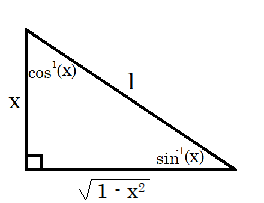Question #5b2ef
1 Answer
It doesn't. Maybe check the problem to see if it's written differently? Otherwise, this equality is false.
We can solve for
Explanation:
Take the inverse cosine of both sides:
#cos(sin^-1(x) - cos^-1(x)) = cos(cos^-1(x/2))#
#cos(sin^-1(x) - cos^-1(x)) = x/2#
Now use the difference rule for cosines:
#cos(a-b) = cos(a)cos(b) + sin(a)sin(b)#
Therefore we can say that:
#cos(sin^-1(x))cos(cos^-1(x)) + sin(sin^-1(x))sin(cos^-1(x)) = x/2#
#cos(sin^-1(x))(x) + (x)sin(cos^-1(x)) = x/2#
~~~~~~~~~~~~~~~~~~~~~~~~~~~~~~~~~~~~~~~~~~~~~~~~~~~~~~~~~~~
We can write an algebraic expression for
The sine of the top angle, and the cosine of the bottom angle, are both
#sin(cos^-1(x)) = cos(sin^-1(x)) = sqrt(1-x^2)#
~~~~~~~~~~~~~~~~~~~~~~~~~~~~~~~~~~~~~~~~~~~~~~~~~~~~~~~~~~~
And now we can substitute this into our first equation:
#sqrt(1-x^2)(x) + (x)sqrt(1-x^2) = x/2#
#2xsqrt(1-x^2) = x/2#
Hmm... this isn't starting to look equal. Let's divide both sides by
#sqrt(1-x^2) = 1/4#
#1-x^2 = 1/16#
#15/16 = x^2#
#+-sqrt15/4 = x#
Well, we've shown that this equation is ONLY true for certain values of
Either way, it's worth noting that the inverse cosine function is only defined for
#x = sqrt15/4#
Final Answer


